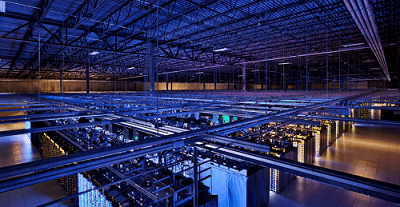The Rise of the Hyperscale Data Center
October 25, 2017 / General, Installation and testing, Upgrading and troubleshooting, Industrial Networks
While the number of hyperscale data centers in the world is only estimated at around 300, with half of these belonging to U.S.-based companies (Think Amazon, Google, Microsoft, Facebook, Ebay and Twitter) and another 100 hyperscale data centers expected by the end of 2018, we are constantly hearing rumbles about these unique spaces.
Plus, hyperscales tend to be key drivers behind data center technologies, trends and applications—not to mention standards development. Would the IEEE really be working on 400 Gig if it weren’t for these giants?
More than Size
 What exactly makes a data center a hyperscale data center? While some define hyperscale data centers as being extremely large, it’s more than just size, and it’s really all in the name if you think about it—hyper meaning “excessive, above normal” and scale meaning “the relative extent or range.” The key attribute of a hyperscale data center is one that is massively scalable in terms of being able to quickly and efficiently increase computational power, data rate and the overall number of machines to whatever extent is required.
What exactly makes a data center a hyperscale data center? While some define hyperscale data centers as being extremely large, it’s more than just size, and it’s really all in the name if you think about it—hyper meaning “excessive, above normal” and scale meaning “the relative extent or range.” The key attribute of a hyperscale data center is one that is massively scalable in terms of being able to quickly and efficiently increase computational power, data rate and the overall number of machines to whatever extent is required.
These spaces tend to be made up of distributed systems with hundreds of thousands of servers, many of which have much higher workload requirements than we see in typical enterprise data centers, such as websites with extreme traffic, 3D rendering, Big Data analytics and other specialized needs. Another characteristic of hyperscale data centers is that they tend to be designed using primarily singlemode optical fiber since multimode does not typically have the reach and bandwidth they require. They also tend to have flatter architectures with fewer switch tiers to reduce latency. For server interfaces, hyperscale data centers are pushing the migration to 25 gigabit speeds and beyond, and many hyperscales are trending toward all-fiber infrastructures.
Keeping Track of it All
With the sheer number of fiber links in a hyperscale data center—we’re talking about tens of thousands of miles of fiber cabling and hundreds of thousands of fiber links—it can’t be easy to keep track of it all when it comes time for testing or troubleshooting.
In the past, collecting and consolidating data from separate testers was extremely time consuming. And when you start talking about a hyperscale data center, imagine that task times 100 (or more). This makes Fluke Networks’ cloud-based LinkWare Live ideal for the hyperscale—not only can multiple testers be configured and programmed with cable IDs ahead of time to reduce errors and maintain consistency, but test data from multiple testers being used by multiple technicians can effortlessly be consolidated into a single project. This means you get all the data and can avoid retesting due to missing results. And LinkWare Live supports an unlimited number of projects and offers unlimited storage—now averaging over 300,000 test results uploaded per month, it’s the perfect fit for the hyperscale.





